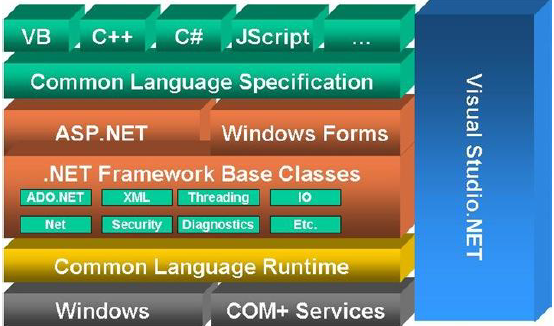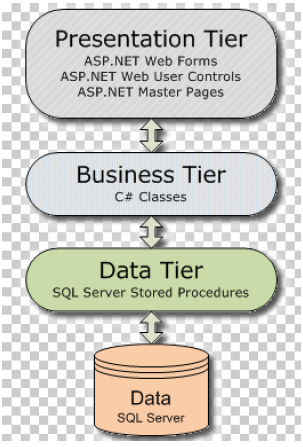Cost: INR 290/-
Get This Project
 Figure 2.1 ASP.NET Framework Architecture[/caption]
ASP.NET is a part of .NET framework and is a web-application framework. It is built on the Common Language Runtime (CLR) which allows programmers to build dynamic web applications, web services and web sites and also allows them to write ASP.NET code using any .NET language. The languages that are compatible with CLR include Microsoft Visual Basic, C#, J# and Jscript.NET. These languages enable the programmers to develop the applications that benefit from the CLR, inheritance, type safety etc,
DESIGN AND IMPLEMENTATION
[caption id="attachment_20766" align="alignnone" width="303"]
Figure 2.1 ASP.NET Framework Architecture[/caption]
ASP.NET is a part of .NET framework and is a web-application framework. It is built on the Common Language Runtime (CLR) which allows programmers to build dynamic web applications, web services and web sites and also allows them to write ASP.NET code using any .NET language. The languages that are compatible with CLR include Microsoft Visual Basic, C#, J# and Jscript.NET. These languages enable the programmers to develop the applications that benefit from the CLR, inheritance, type safety etc,
DESIGN AND IMPLEMENTATION
[caption id="attachment_20766" align="alignnone" width="303"] Figure 3.1 Three tier architecture[/caption]
This chapter describes about the architecture used in this project and the three tier architecture is used. The three tier architecture is a client-server architecture in which user interfaces, functional business logic, data storage and data access are developed and maintained as independent modules, often on different platforms. This model is considered to be software architecture and a software design pattern. This architecture allows any of the three tiers to be upgraded independently as requirements or technology change and is described in detail in the below sections.
[caption id="attachment_20767" align="alignnone" width="631"]
Figure 3.1 Three tier architecture[/caption]
This chapter describes about the architecture used in this project and the three tier architecture is used. The three tier architecture is a client-server architecture in which user interfaces, functional business logic, data storage and data access are developed and maintained as independent modules, often on different platforms. This model is considered to be software architecture and a software design pattern. This architecture allows any of the three tiers to be upgraded independently as requirements or technology change and is described in detail in the below sections.
[caption id="attachment_20767" align="alignnone" width="631"] Figure 3.2 Data flow among the three tiers[/caption]
From the figure all the fields and keys of the tables can be noticed. So because of all the above said functionalities of the three tier architecture, I felt it matches with all my requirements of the project and hence I have decided to go with three tier architecture for my current application. The figure 3.2 which is below describes the data flow among the three tiers.
[caption id="attachment_20768" align="alignnone" width="507"]
Figure 3.2 Data flow among the three tiers[/caption]
From the figure all the fields and keys of the tables can be noticed. So because of all the above said functionalities of the three tier architecture, I felt it matches with all my requirements of the project and hence I have decided to go with three tier architecture for my current application. The figure 3.2 which is below describes the data flow among the three tiers.
[caption id="attachment_20768" align="alignnone" width="507"] Figure 3.3 Student Use case Diagram[/caption]
In the Unified Modeling Language (UML), the use case diagram is a type of behavioral diagram defined by and created from a use-case analysis. It represents a graphical over view of the functionality of the system in terms of actors, which are persons, organizations or external system that plays a role in one or more interaction with the system. These are drawn as stick figures. The goals of these actors are represented as use cases, which describe a sequence of actions that provide something of measurable value to an actor and any dependencies between those use cases.
TESTING
[caption id="attachment_20769" align="alignnone" width="900"]
Figure 3.3 Student Use case Diagram[/caption]
In the Unified Modeling Language (UML), the use case diagram is a type of behavioral diagram defined by and created from a use-case analysis. It represents a graphical over view of the functionality of the system in terms of actors, which are persons, organizations or external system that plays a role in one or more interaction with the system. These are drawn as stick figures. The goals of these actors are represented as use cases, which describe a sequence of actions that provide something of measurable value to an actor and any dependencies between those use cases.
TESTING
[caption id="attachment_20769" align="alignnone" width="900"] Figure 4.1 Screen Shot of NUnit Test case Execution[/caption]
To perform unit testing I have tested a few of basic functions of my current application. Each of those functions is given below. The five test cases which I have executed against the application using NUnit tool are explained below in detail. I have tested all possible methods using NUnit testing and for the rest of the methods I have done manual testing. I have included all the test cases into one test suite and executed all of them at a time.
CONCLUSION AND FUTURE WORK
Conclusion
The online student profile management system is been designed for the students and faculty so that the filing of the program of study can be made easier and faster. The students can easily pick the program option as well as courses from the drop down menus provided and can submit their POS. They can also view the preview of the selection of the courses.
Faculty in turn can also view the POS of the student. Implementing of this application gave me a good learning experience and exposure to the technologies which I have used in this project viz., Visual Studio 2005, C#.NET language and SQL Server 2005. Just choosing the courses from the drop down menu would make users comfortable with the application and easy to use.
Over all Experience
The current application, online student profile management system which is a .NET web application is been developed using ASP.NET 2.0, SQL Server 2005 in the C# programming language. By implementing this project, I have gained a good learning experience with C#.NET programming language. Earlier I had experience working on SQL server management studio and that helped me a lot while working on this project while designing the database, writing SQL queries etc.,.
Future Enhancements to the Project
The following changes can be made to the application in future:-
Figure 4.1 Screen Shot of NUnit Test case Execution[/caption]
To perform unit testing I have tested a few of basic functions of my current application. Each of those functions is given below. The five test cases which I have executed against the application using NUnit tool are explained below in detail. I have tested all possible methods using NUnit testing and for the rest of the methods I have done manual testing. I have included all the test cases into one test suite and executed all of them at a time.
CONCLUSION AND FUTURE WORK
Conclusion
The online student profile management system is been designed for the students and faculty so that the filing of the program of study can be made easier and faster. The students can easily pick the program option as well as courses from the drop down menus provided and can submit their POS. They can also view the preview of the selection of the courses.
Faculty in turn can also view the POS of the student. Implementing of this application gave me a good learning experience and exposure to the technologies which I have used in this project viz., Visual Studio 2005, C#.NET language and SQL Server 2005. Just choosing the courses from the drop down menu would make users comfortable with the application and easy to use.
Over all Experience
The current application, online student profile management system which is a .NET web application is been developed using ASP.NET 2.0, SQL Server 2005 in the C# programming language. By implementing this project, I have gained a good learning experience with C#.NET programming language. Earlier I had experience working on SQL server management studio and that helped me a lot while working on this project while designing the database, writing SQL queries etc.,.
Future Enhancements to the Project
The following changes can be made to the application in future:-
- Currently I have implemented this application that can be used by only CIS majors in our university, this application may be extended to be used by students of other majors of college of engineering.
- The current system is only confined to graduate students. More functionality can be added so that it can be extended to use by under graduate and PhD students also.
- The application can be extended so that it facilitates even the faculty members to create their own profile and non-faculty members to check if a student has filed his/her POS or not.
- Can add more features and refine the current website in order to make it appear prettier and more interactive.